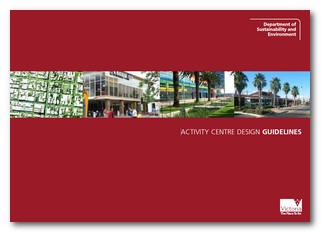Car parking and walking
Perceptions of car parking
 Part of the Watergardens town centre car park (photo: Google Maps)
Part of the Watergardens town centre car park (photo: Google Maps)
Anyone who works in planning or transport knows that car parking is a contentious issue. However the evidence suggests that car parking is not as important to shoppers as others, notably retailers, believe.
In 2008, the City of Darebin conducted a travel survey of 736 visitors and 133 businesses in the Northcote shopping precinct to assess the potential impact of a reduction in parking on High Street. Business respondents placed a measurably greater level of importance on the availability of parking than the visitors (8.23 compared to 7.11 out of 10). Of businesses surveyed, 47% were not prepared to lose any car spaces, compared to only 29% of shoppers. This is consistent with the fact that businesses dramatically overestimated the proportion of people who drove to their shops (56% compared to an actual 33%) and underestimated walking (17% vs actual 36%).
This is consistent with overseas research, such as that set out in The relevance of parking in the success of urban centres. This found that "in all the studies that looked at shoppers' mode of travel, shopkeepers have consistently overestimated the proportion of their customers who come by car." The level of overestimation was often 100% and up to 400% in one instance. Walkers also spent the most in centres they accessed, while drivers spent the least of all transport modes.
Planning requirements

In 2009 the Department of Transport commissioned an international review of the literature regarding techniques to promote walking and cycling. This review found that the availability of free car parking was one of the key factors that promoted driving over other forms of transport (Krizek, Forsyth and Baum 2009).
A more recent review of international literature reached a similar conclusion. “Hindsight shows that minimum parking requirements have had hugely negative consequences... Travel behaviour studies show a strong link between the availability and cost of parking and people’s tendency to drive.” (Donovan and Munro 2013, p.50)
The significance of car parking for walking in particular relates to the fact that, in addition to promoting vehicle use, when provided in the form of large scale ground level parking lots, it actively discourages walking. “Not only does ample and free parking provide an easy excuse for auto travel, vast parking areas are also the bane of pedestrian travel.” (Krizek, Forsyth and Baum 2009, p.15)
Despite limited changes to Victorian parking requirements made in mid 2012, the Victoria Planning Provisions (VPPs) still require car parking beyond the levels that business would naturally supply, promoting vehicle use at the expense of other transport modes. A fundamental review of Victorian car parking requirements is needed.
This short (6 minute) American video explains the problems of car parking requirements.
Options for councils

While the VPPs strongly promote car parking, there are options for councils to manage car parking appropriately.
- Councils can expedite planning permit applications to reduce or waive car parking requirements. Full waiver of car parking requirements should be utilised for changes of use and development in traditional retail centres.
- In considering proposals for retail development, the adverse amenity impacts of the car parking that is provided need to be carefully managed. Large areas of at-grade car parking between shops and the street must be avoided, as they strongly discourage walking. Car parking should be located above, below or behind shops. While this will often be resisted by retailers and developers, because they generally want to facilitate driving to stores, planners can draw support from the official Victorian Activity Centre Design Guidelines.
- The VPPs now allow a council to vary the standard parking requirements through application of the parking overlay (clause 45.09), although this requires preparation of a car parking plan and a planning scheme amendment to implement it. Practice Note 57 sets out the process.
- Broader strategic planning processes for activity centres should emphasise the desirability of waiving or reducing car parking requirements; minimise the adverse amenity impacts of the car parking that is provided; and generally promote pedestrian oriented design.
- Councils can impose charges or time restrictions on on-street car parking to ensure it is efficiently utlised and driving is discouraged for long term visitors or workers in activity centres.
Practice Note 22 provides broader guidance on the parking provisions.